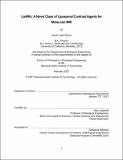| dc.contributor.advisor | Alan Jasanoff. | en_US |
| dc.contributor.author | Simon, Jacob Cyert. | en_US |
| dc.contributor.other | Massachusetts Institute of Technology. Department of Biological Engineering. | en_US |
| dc.date.accessioned | 2021-05-25T18:21:09Z | |
| dc.date.available | 2021-05-25T18:21:09Z | |
| dc.date.copyright | 2021 | en_US |
| dc.date.issued | 2021 | en_US |
| dc.identifier.uri | https://hdl.handle.net/1721.1/130814 | |
| dc.description | Thesis: Ph. D., Massachusetts Institute of Technology, Department of Biological Engineering, February, 2021 | en_US |
| dc.description | Cataloged from the official PDF version of thesis. | en_US |
| dc.description | Includes bibliographical references (pages 87-104). | en_US |
| dc.description.abstract | Biological systems depend on numerous molecular messengers that transduce information across large distances. Understanding the spatial and temporal dynamics of molecular signaling networks is crucial for the construction of systems- and organism-level models of biological function. Molecular imaging, a technique that employs chemical probes to relay molecular events into spatially-resolved signal changes, is a promising strategy for studying complex molecular signaling networks in situ. Magnetic resonance imaging (MRI) is a leading noninvasive imaging modality that allows for imaging of large volumes of deep tissue with high spatiotemporal resolution. Paramagnetic molecular sensors enable detection of molecular phenomena with MRI (molecular MRI). The scope of molecular MRI experiments thus far, however, has been limited by the modest sensitivity and signal changes provided by existing probes. | en_US |
| dc.description.abstract | In this dissertation, I introduce Ḻiposomal Ṉanoparticle Ṟeporters (LisNRs), a novel class of MRI-detectible sensor that utilizes an innovative contrast mechanism in which reversible modulation of the water permeability of liposomal bilayers simultaneously modulates water access to a large, concentrated pool of conventional T1-weighted MRI contrast agents. This architecture gives rise to significant signal amplification with respect to first-generation MRI probes that rely on stoichiometric sensing mechanisms in which binding of one analyte molecule modulates water access to a single paramagnetic metal ion. I employ two strategies for the signal-dependent modulation of liposomal water permeability. The first approach uses reversible modulation of lipid bilayer fluidity to induce changes in passive bilayer water permeability. To demonstrate this concept, I build Light- LisNR, a photosensitive MRI contrast agent, which I use to map light distribution in the rat brain. | en_US |
| dc.description.abstract | The second approach utilizes ligand-gated water-permeable channels to modulate bilayer water permeability. I demonstrate the potential of this strategy for molecular sensing using biotin/streptavidin as a model system. Together, this work introduces and demonstrates a novel platform for sensing with MRI that addresses longstanding challenges of low sensitivity and signal change with existing MRI-detectible probes. | en_US |
| dc.description.statementofresponsibility | by Jacob Cyert Simon. | en_US |
| dc.format.extent | 104 pages | en_US |
| dc.language.iso | eng | en_US |
| dc.publisher | Massachusetts Institute of Technology | en_US |
| dc.rights | MIT theses may be protected by copyright. Please reuse MIT thesis content according to the MIT Libraries Permissions Policy, which is available through the URL provided. | en_US |
| dc.rights.uri | http://dspace.mit.edu/handle/1721.1/7582 | en_US |
| dc.subject | Biological Engineering. | en_US |
| dc.title | LisNRs : a novel class of liposomal contrast agents for molecular MRI | en_US |
| dc.title.alternative | Liposomal nanoparticle reporters | en_US |
| dc.type | Thesis | en_US |
| dc.description.degree | Ph. D. | en_US |
| dc.contributor.department | Massachusetts Institute of Technology. Department of Biological Engineering | en_US |
| dc.identifier.oclc | 1252627402 | en_US |
| dc.description.collection | Ph.D. Massachusetts Institute of Technology, Department of Biological Engineering | en_US |
| dspace.imported | 2021-05-25T18:21:09Z | en_US |
| mit.thesis.degree | Doctoral | en_US |
| mit.thesis.department | BioEng | en_US |
